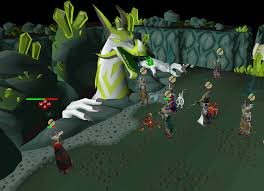Old School RuneScape (OSRS) Raids offer some of the most challenging and rewarding PvM (Player vs. Monster) content in the game. Raids require not only a strong character but also a solid understanding of the mechanics, bosses, and strategies to achieve success. This guide will cover everything you need to know about OSRS Raids, from preparation and strategy to tips on maximizing your loot.
What Are OSRS Raids?
OSRS Raids are group PvM activities in which players band together to battle through various stages filled with monsters, puzzles, and boss encounters. Unlike other PvM experiences in OSRS, raids are designed to be completed with teams, making cooperation and communication essential. The primary OSRS raids are Chambers of Xeric and Theatre of Blood, each offering unique challenges and valuable rewards.
Both raids require different approaches, preparation, and equipment setups, so understanding the differences between them is crucial. Successfully completing a raid can yield some of the best items in OSRS, making them highly sought-after by players.
Chambers of Xeric
The Chambers of Xeric was the first raid introduced to OSRS. Known for its random layout, which changes every time you enter, this raid requires adaptability and a diverse skill set. It can be completed with one player but is typically more efficient with a team.
Requirements
The Chambers of Xeric doesn’t have any specific level requirements, but having high levels in key skills like combat, agility, and fishing can be beneficial, as these skills can influence your performance and survival. A high combat level (80+ in most stats) is recommended, as well as decent gear.
Bosses and Puzzles
Chambers of Xeric consists of multiple rooms, each containing puzzles or bosses that players must defeat to progress. Some notable bosses include:
- Vasa Nistirio: Known for its powerful ranged and magic attacks.
- Tekton: A melee-based boss that hits hard but can be avoided by quick movement.
- Vespula: A boss that attacks with magic and summons, requiring coordination to defeat.
These bosses require varying strategies, making it crucial for teams to communicate effectively.
Olm, the Final Boss
The final encounter in the Chambers of Xeric is the Great Olm, a massive dragon-like creature with different phases. Olm can deal damage with magic, ranged, and melee attacks, making it a multi-dimensional fight. The team must work together to control Olm’s attacks while managing its various mechanics, including acid pools and healing crystals.
Loot and Rewards
Loot from the Chambers of Xeric is distributed based on player performance. Rare rewards include powerful items such as the Twisted Bow, Ancestral Robes, and the Dragon Hunter Crossbow. These items are highly valuable and can significantly enhance a player’s PvM and PvP capabilities.
Theatre of Blood
The Theatre of Blood is known as one of the most challenging PvM activities in OSRS. Unlike the Chambers of Xeric, the Theatre of Blood has a set sequence of bosses that players must face. Each boss presents a different set of mechanics, and the raid requires not only skill but also quick reflexes and coordination.
Requirements
While there are no official level requirements, players typically need high combat stats, ideally above 90, and experience in PvM activities. Good gear, such as Bandos armor, Armadyl Crossbow, or even Justiciar Armor, is recommended. Players who enter the Theatre of Blood should be prepared for a steep learning curve.
Key Bosses
The Theatre of Blood consists of several bosses that players must defeat in sequence. Key bosses include:
- Maiden of Sugadinti: A powerful magic user that summons blood spawns, which deal damage if not managed correctly.
- Bloat: A large, lumbering creature that players must avoid by carefully timing their movements.
- Sotetseg: Known for its deadly maze mechanics, Sotetseg requires the team to stay focused and coordinate positioning.
Each boss in the Theatre of Blood has mechanics that can wipe out a team if not handled properly. The difficulty and unforgiving nature of these encounters make the Theatre of Blood one of OSRS’s hardest PvM challenges.
Verzik Vitur, the Final Boss
The final encounter is Verzik Vitur, a powerful vampyre queen with multiple phases. Each phase demands different strategies, and Verzik’s attacks can devastate an unprepared team. The key to defeating Verzik is understanding each phase and working with teammates to avoid her deadly attacks.
Rewards and Loot
Successfully completing the Theatre of Blood rewards players with valuable loot, including the Scythe of Vitur, Justiciar Armor, and the Ghrazi Rapier. These items are highly sought after and can be sold for a high price, making the Theatre of Blood a profitable but challenging raid.
Essential Tips for OSRS Raids
1. Communication is Key
Effective communication is essential for success in OSRS raids. Make sure everyone in your team understands their roles and responsibilities before starting. Use voice chat if possible to coordinate during high-pressure moments, especially in encounters like Verzik Vitur or the Great Olm.
2. Learn Boss Mechanics
Each boss in OSRS raids has unique mechanics that can be learned through practice and observation. Understanding how each boss behaves, including its attack patterns and special abilities, will greatly improve your chances of survival. Some players even use practice mode to hone their skills before attempting raids for loot.
3. Bring the Right Gear
Having the right gear can make a significant difference. For Chambers of Xeric, a balance of melee, magic, and ranged equipment is essential. In the Theatre of Blood, melee gear tends to be more effective, though certain bosses may require a different approach. Gear setups can be costly, but using items like Dragon Warhammer or Toxic Blowpipe can boost damage against certain bosses.
4. Manage Your Supplies
Proper management of supplies such as food, potions, and stamina is crucial in OSRS raids. Bring a mix of Saradomin Brews and Super Restores to ensure you can heal effectively. In Chambers of Xeric, fishing can help you restock supplies if your team runs low during the raid.
5. Adapt to Your Team
Each player has different strengths and weaknesses, so it’s important to adapt to the capabilities of your team. If someone is less experienced, assign them to a safer role, while more experienced players can handle more challenging tasks. Adapting your strategy to fit the team can improve your success rate significantly.
OSRS Raids Solo vs. Team Play
While OSRS Raids are typically done in groups, some experienced players attempt to complete raids solo. Soloing is much more challenging and requires an in-depth knowledge of boss mechanics, as well as top-tier gear and supplies. Here’s a quick look at the pros and cons of solo vs. team play:
Solo Raids
- Pros: Greater challenge, full control over actions, keep all loot.
- Cons: Higher difficulty, need for excellent gear, limited room for mistakes.
Team Raids
- Pros: Shared responsibilities, faster completion, more strategy options.
- Cons: Loot is split, requires good communication, risk of less experienced teammates.
Solo raids can be rewarding for experienced players looking for a challenge, while team raids offer more flexibility and a chance for players of all skill levels to participate.
Rewards and Drop Rates in OSRS Raids
Rewards from OSRS raids are among the best in the game. Each player’s chance of receiving rare items increases with their personal contribution and performance during the raid. Here’s a breakdown of some of the notable rewards:
Chambers of Xeric Rare Drops
- Twisted Bow: A powerful ranged weapon, particularly effective against magic-based enemies.
- Elder Maul: A high-damage melee weapon.
- Kodai Insignia: Grants access to the Kodai Wand, a strong magic weapon.
Theatre of Blood Rare Drops
- Scythe of Vitur: One of the most coveted weapons in OSRS for its high damage output.
- Ghrazi Rapier: A versatile weapon that excels in both PvM and PvP situations.
- Justiciar Armor: Provides strong defensive bonuses, especially useful in PvM scenarios.
The value of these items makes OSRS raids an attractive activity for high-level players, as a single rare drop can be worth tens or even hundreds of millions of GP (Gold Pieces).
Preparing for Your First OSRS Raid
Recommended Stats and Skills
Although there are no official requirements for OSRS raids, high-level stats in combat skills such as Attack, Strength, Defence, Magic, and Ranged are strongly recommended. Additionally, skill levels in Agility, Herblore, and Prayer will also help during raids.
Recommended Gear
Ideal gear setups vary depending on the raid and team setup. Here are some commonly used items in OSRS raids:
- Melee Gear: Bandos armor, Dragon Warhammer, Scythe of Vitur (Theatre of Blood)
- Ranged Gear: Twisted Bow, Armadyl Crossbow, Toxic Blowpipe (Chambers of Xeric)
- Magic Gear: Kodai Wand, Ancestral Robes, Trident of the Swamp (Chambers of Xeric)
Remember to adjust your gear based on the bosses you’re fighting and the roles you’ll play within your team.
Conclusion: Why OSRS Raids Are Worth the Challenge
OSRS raids offer a unique combination of teamwork, skill, and high-stakes rewards that make them one of the most exciting PvM activities in Old School RuneScape. Whether you’re challenging the randomized Chambers of Xeric or braving the unforgiving Theatre of Blood, raids offer something for everyone—from casual players to hardcore PvMers. By following the strategies, tips, and gear recommendations outlined in this guide, you’ll be well-prepared to tackle the thrilling challenges of OSRS raids and claim some of the game’s most sought-after loot.











